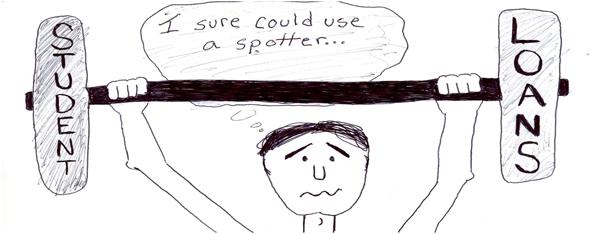If you’re a college senior, no doubt, the issue of student loans and debt is on your mind.
It was reported in 2010 that the college graduate averaged $25,250 in student loan debt; the NMU class of 2010 racked up an average of $27,091 in debt, according to the same study.
The last report from the Bureau of Labor Statistics put the unemployment rate at 8.1 percent. What does that mean for us?
In a time of economic uncertainty, jobs are hard to come by and debt can weigh heavily on students’ finances.
More and more graduates are moving back in with their parents, working at jobs they are overqualified for and compromising to make ends meet.
After obtaining a bachelors degree, it can be demoralizing to serve a plethora of double-downs at KFC while making minimum wage. This is not what most students signed up for.
The question now is: what should we, at the university level, do about the crippling debt that college grads face?
I’ve heard so many say that something needs to change but they offer no solutions.
The Student Loan Forgiveness Act, which was recently introduced in Congress, is a possible solution.
It would transfer the $1 trillion dollar debt of college students to the government, which ultimately taxpayers (including students) will have to pay back.
What would relieve one group of people would, ultimately, place the burden upon the collective whole.
A stigma would befall us: we would be the “Bailout Generation.”
Don’t get me wrong, I’d love to have my student loans forgiven but what am I being forgiven for, financial recklessness?
That is the problem: a large majority of students enroll in a university whose tuition they cannot afford.
Of course I’d like to go to an Ivy League school, but I know I am not able to afford such an education.
If you have a certain budget and you go shopping for a car, you have to come to the realization that you cannot buy the Mercedes Benz; yes, you’d like it, but you cannot afford it.
Instead, you’ll have to compromise and hop into a new Ford Focus.
What is the problem with our public universities then?
They readily give out federal loans for a college education; there is often little paper work filled out.
No one evaluates a student’s ability to pay his or her loans back.
Essentially, universities are giving loans out for luxury educations when students cannot afford them, a Benz degree that cannot be afforded with a Focus salary.
Let’s say that someone has amassed $60,000 in debt (not uncommon) and he or she works as a social worker making an average, according to 2010 BLS data, of $42,480. That is a lot of debt to pay off for that particular degree.
I’m not picking on social workers, but I am making an example of those who work for the public benefit, like teachers and police officers. We need these people.
How do these people pay that debt off, especially as it accrues interest over the years?
They move in with their parents, work three jobs, and delay the milestones—buying a house, getting married, having children.
I can recall when I was first shopping around for my college education.
I wanted to attend MSU, but they expected me to pay more than $25,000 a year.
I was lucky to have a father who talked me off the ledge of financial suicide (I was determined to go to MSU), but others may not be so fortunate.
There are few resources for incoming college students.
Public universities should offer financial advisers for students in the same way that they offer academic advisers.
A college freshman is loose and fast with his money; I know because I was that freshman.
For most, it is the first time out of the house and impetuous spending occurs when the nectar of freedom is sampled.
It is unlikely he or she is wondering, “What will my total debt be after I graduate with my degree?”
It is easy to accumulate a massive amount of student debt throughout your time spent in college.
It is the responsibility of a student to manage their finances and a university’s responsibility to help students plan their finances.
Someone has to extend the olive branch to college students, lest we fall off a financial cliff into a pool of debt. Don’t let us go the way of the “Price is Right” Cliff Hanger.























